Slovenian Economic Mirror
Related Files:
Slovenian Economic Mirror 2/2022
In Slovenia, most indicators suggest that the relatively favourable trends in economic activity observed at the end of last year are continuing. In the last quarter of 2021, manufacturing output and trade in goods increased significantly, and export expectations remain high. Household consumption also remained high in the last quarter of 2021, partly due to the low base last year. Given the stronger impact of the containment measures, overall turnover in accommodation and food service activities, creative, arts and entertainment activities, gambling and betting activities, and travel agency activities remains below pre-crisis levels. Economic sentiment improved slightly again in January in most activities, while confidence in manufacturing and among consumers remained at the same level as in December last year. Inflation increased markedly year-on-year in January, with sharp rises in energy, food and services prices. Conditions in the labour market remain good. There were 67,834 people registered as unemployed at the beginning of the year (25.9% more than in January last year) and the number of long-term unemployed continued to decline. In the Selected topic, we focused on the solvency of business entities during the COVID-19 crisis. Among other things, we note that in the last two years more companies were registered in the business register than were deleted from it.
Related Files:
- International environment
- Economic developments
- Labour market
- Prices
- Balance of payments
- Financial markets
- Public finance
Quarterly economic growth in Slovenia’s main trading partners

Compared to the previous quarter, economic growth in the euro area slowed significantly in the last quarter of 2021 and similar trends are continuing at the beginning of this year. According to Eurostat’s flash estimate, GDP increased by 0.3% quarter-on-quarter (by 4.6% year-on-year), reaching pre-crisis levels. Among Slovenia’s main trading partners, quarter-on-quarter growth was recorded in France and Italy (0.7% and 0.6% respectively), while GDP in Germany and Austria fell by 0.7% and 2.2% respectively. The available indicators show that the slowdown in economic growth in the euro area continued at the beginning of the first quarter of 2022. The value of the composite Purchasing Managers’ Index (PMI) in January was the lowest in the last 11 months, this due to the decline in the services PMI amid the increase in Omicron infections and the tightening of containment measures. However, the worsening of the epidemiological situation had no impact on the manufacturing PMI, which rose to its highest level in five months, according to enterprises’ reports, due to easing of supply chain pressures.
International Monetary Fund (IMF) forecasts of economic growth

According to international institutions, economic growth in most of the world’s major economies will slow this year. After the rebound of the global economy last year (by 5.9%), the IMF forecasts growth of 4.4% this year, half a percentage point less than was forecast in October. A further slowdown to 3.8% is forecast for 2023. Forecasts for the world’s two largest economies and for Slovenia’s main export partner (Germany) have deteriorated significantly in the face of the ongoing pandemic and higher energy prices and supply chain disruptions and resulting higher inflation. After last year’s modest growth of 2.8%, the IMF and EC forecast GDP growth of 3.8% and 3.6% respectively for Germany this year. Similar growth is expected for Italy and France this year (6.2% and 7% respectively last year). The forecast is accompanied by a number of risks, including the development of the pandemic, a tightening of US monetary policy and its impact on global financing conditions, supply chain disruptions, higher energy prices and possible wage pressures that could lead to even higher inflation, and a worsening of problems in China’s real estate sector.
Commodity prices

Commodity prices on international markets mostly rose in January. In the face of limited supply and geopolitical tensions, the average dollar price of Brent Crude fell by 16.5% to USD 86.5 per barrel (and was thus up by 57.9% year-on-year). In January, natural gas prices on the European market fell by 25.7% compared to the previous month but remained 288.8% higher year-on-year. Energy prices remain the biggest contributor to high year-on-year inflation, which stood at 5.1% in the euro area in January. According to the World Bank, non-energy commodity prices on international markets also rose in January, up 4% from the previous month and 8% year-on-year. Higher energy prices have a strong impact on the production costs of non-energy commodities. The strongest month-on-month increase was recorded for metals and minerals (+7.3%) and year-on-year for fertilisers (+141.8%). According to the IMF, non-energy commodity prices are expected to rise by about 3% this year following last year’s high growth and then fall again in 2023.
Short-term indicators of economic activity in Slovenia
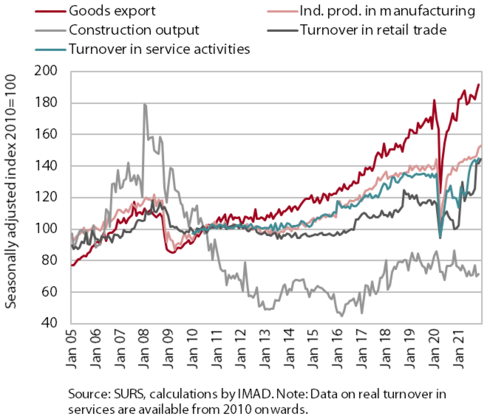
In Slovenia, most indicators suggest that the relatively favourable trends in economic activity which were seen at the end of last year continue, while uncertainties due to the epidemiological situation are still present in service activities. Manufacturing output rose significantly in the last quarter of last year, as did trade in goods, with export expectations remaining high at the beginning of this year. In the last quarter of last year, household spending on non-food products increased, and the sales of automotive fuels also rose sharply, due not only to higher freight traffic but also to sales to transit customers. At the end of last year, turnover increased again in market services, with only that of travel and employment agencies falling significantly below pre-epidemic levels. Activity in construction was still lower year-on-year at the end of last year. High price growth in construction services continued due to rising commodity prices and labour shortages. The increase in trade in services was mainly due to the increase in transportation services. Trade in construction and other business services was also higher, while the recovery in tourism-related services came to a halt. According to data on fiscal verification of invoices, turnover in January was up 30% year-on-year, partly due to last year’s low base as a result of containment measures, and was 7% lower than in January 2020; accommodation and food service activities, creative, arts and entertainment activities, and gambling and betting activities also remained below pre-crisis levels, as did turnover in trade. Economic sentiment improved slightly again in January in most activities, while confidence in manufacturing and among consumers remained at the same level as in December last year.
Electricity consumption
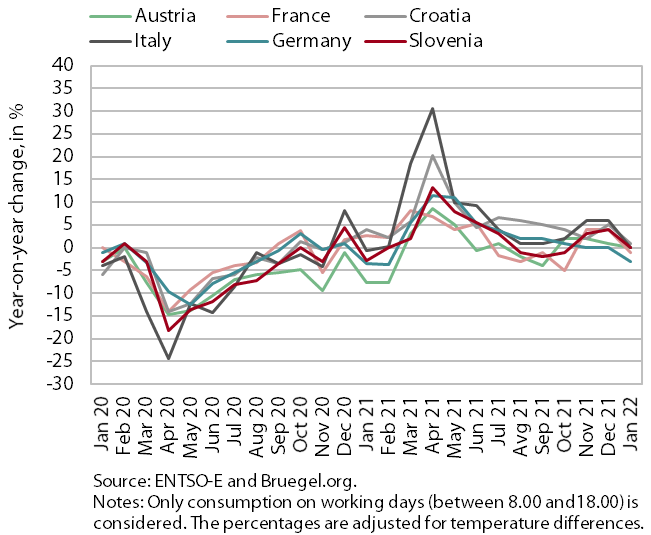
Electricity consumption in January was about the same as in January 2021 but 2% lower than in January 2020. This is also due to the disruption of work processes related to absence of employees caused by the rapid spread of the Omicron variant. Similar trends can be observed among Slovenia’s main trading partners. Compared to January 2021, consumption in January 2022 was about the same in Austria and Italy, while it was lower in Germany and France (3% and 1% respectively) and 1% higher in Croatia. Compared to January 2020, most of Slovenia’s partners recorded lower consumption, Austria by 4% and France, Italy and Germany by about 2%, while Croatia recorded 6% higher consumption.
Electricity consumption by consumption group
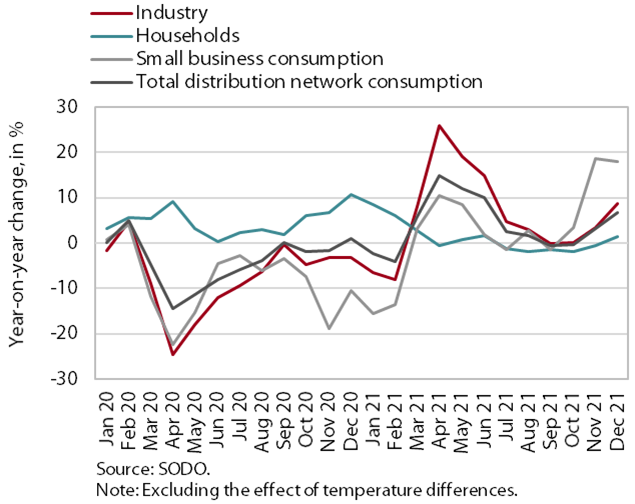
In December 2021, electricity consumption by all consumption groups was higher than in December 2019 and 2020. Compared to December 2020, industrial consumption increased by 8.8%, partly due to a more favourable timing of holidays from the point of view of the functioning of industry in December 2021. Significantly higher (by 18.1%) than in December 2020 was small business consumption, due in particular to the low base in December 2020, when the containment measures were in place, restricting mainly trade and services. Household consumption exceeded the December 2020 figure, when the base was already high, by 1.4%. Compared to December 2019, industrial electricity consumption was 5.4% higher and small business electricity consumption was 5.9% higher, mainly due to the more favourable timing of public holidays. Compared to December 2019, household consumption increased by 12.3% for epidemic-related reasons.
Road and rail freight transport

The volume of road and rail freight transport decreased slightly in the third quarter of 2021, while the volume of road transport remained high. Due to the low base before the second wave of the epidemic last year, the volume of road traffic was almost a tenth higher year-on-year and was also slightly higher than in the third quarter of 2019. Compared to the previous quarter, the volume of road transport performed by Slovenian road freight operators abroad increased by 2%, while the volume of road transport performed at least partially on Slovenian territory (exports, imports and domestic transport combined) decreased by 5%. Rail freight transport, which had been declining before the epidemic, increased slightly year-on-year but was 12% lower than in the same period of the year before the epidemic.
Traffic of electronically tolled vehicles on Slovenian motorways

In January 2022, freight traffic volumes on Slovenian motorways increased by 9% year-on-year. The year-on-year increase was due to an additional working day rather than the impact of a lower base due to the second wave of the epidemic last year. Freight traffic volumes increased by 2% compared to January 2019, which had the same number of working days, and were the same as in January 2020, i.e. before the epidemic. The share of foreign vehicle traffic was 61% this January, the same level as in the same month of the previous three years. January is otherwise one of the three months (along with August and December) with the lowest traffic volumes due to holidays and weather conditions.
Turnover based on fiscal verification of invoices
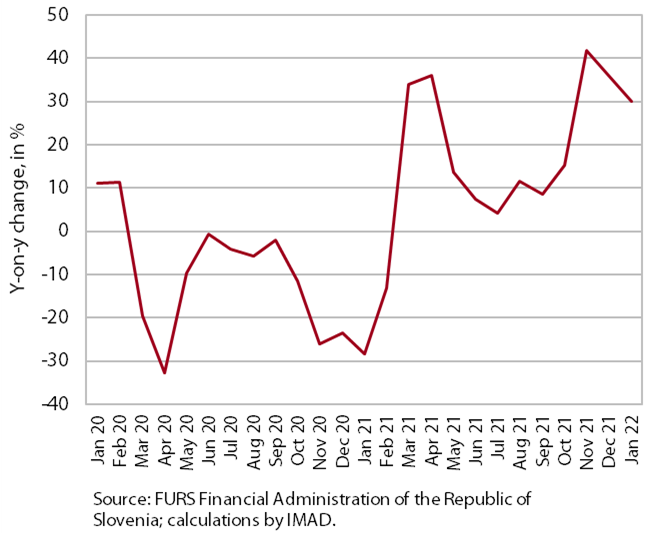
According to data on the fiscal verification of invoices, turnover in January was 30% higher year-on-year and 4% higher than in the same period of 2019. Year-on-year growth was lower than in December, partly due to the worsening epidemiological situation. As a result, the number of people in quarantine, isolation and self-isolation increased, which was reflected in lower year-on-year turnover growth across all sectors. Although growth was lower, it remained very high year-on-year in the activities that were still almost completely shut down at the beginning of 2021, mainly in tourism-related services. Total turnover was 4% higher than in January 2019. Compared to January 2020, it was down 7%, reflecting lower turnover in trade (mainly in the sales of motor vehicles, but also in retail sales, where turnover rose strongly in late January and in February 2020 due to a surge in household inventories). However, the lag behind the January 2019 and 2020 turnover remained large in accommodation and food service activities, creative, arts and entertainment activities, gambling and betting activities, and travel agency activities.
Trade in goods – real
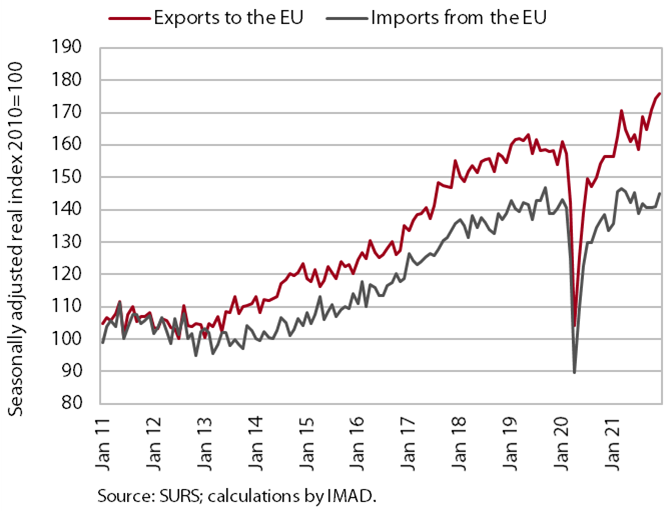
Trade in goods increased in the last quarter of last year and was significantly above pre-epidemic levels. Compared to the previous quarter, real exports of goods rose strongly, especially real exports to EU Member States (6.8% higher, seasonally adjusted). According to the preliminary data, this was mainly due to the growth of exports to Italy and Germany, while exports of vehicles also recovered slightly after a long period of decline. After a decline in the third quarter, imports from EU Member States also increased (by 1.6%, seasonally adjusted). Year-on-year, exports to and imports from EU Member States increased (by 11.4% and 4.2% respectively) and were significantly higher than in the same period of 2019, with imports growing at a lower rate than exports. At the beginning of this year, export expectations remain high but their monthly fluctuations point to continued uncertainty, mainly related to the international environment.
Trade in services – nominal

Trade in services increased in November, exceeding pre-epidemic levels. The increase was mainly due to the recovery in transportation services, while trade in construction and other business services was also higher. Trade in ICT services was lower, and the recovery of tourism-related services stalled. We assess that this was mainly due to the worsening of the epidemiological situation in Slovenia and thus increased uncertainty regarding the tightening of containment measures, as the decline in spending by foreign tourists, same-day visitors and transit passengers in Slovenia was greater than the decline in spending by Slovenian guests abroad. In the first 11 months of 2021, total trade in services was about 7% lower than in the same period of 2019, mainly due to around 46% lower trade volumes in travel services. Trade in personal services, arts and recreation was also down slightly (-2.3%). Other activities are mostly well above pre-epidemic levels.
Production volume in manufacturing
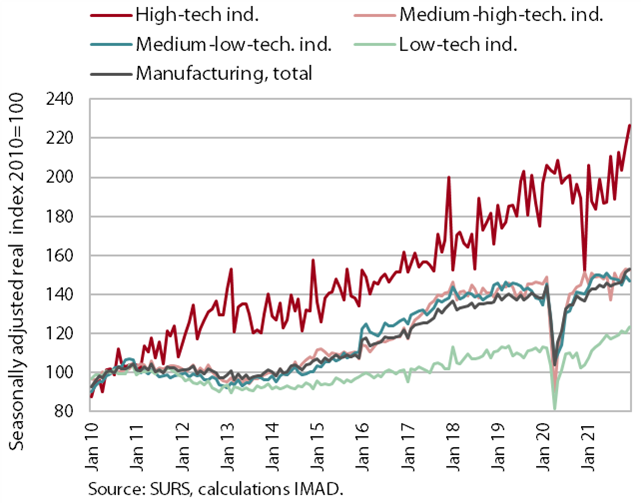
Following a slowdown in the third quarter, manufacturing production increased significantly again in the last quarter of 2021. The increase was mainly driven by strong growth in November. Compared to the previous quarter, activity in high- and medium-high-technology industries increased the most, while growth in medium-low-technology industries was slightly negative. The production volume in manufacturing also increased relatively strongly in the last quarter of 2021 compared to the same period in 2020. This was mainly due to high year-on-year growth in high- and low-technology industries. Solid year-on-year growth was also observed in medium-high- and medium-low-technology industries, despite the negative impact of the downturn in the automotive industry, which is still characterised by large-scale semiconductor supply problems.
Activity in construction
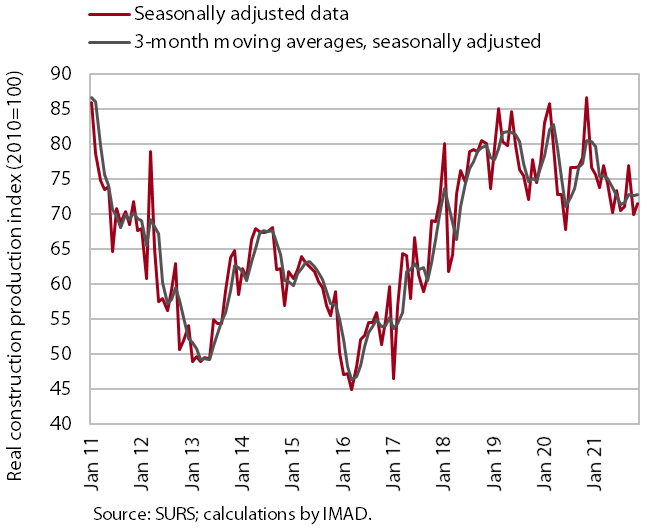
Construction activity increased slightly last November but was still lower than its highest value in late 2020 and early 2021. Overall construction activity was lower last year than in the previous two years and fluctuated widely by individual construction segment from month to month. Amid these fluctuations, activity in civil engineering works and specialised construction remains at the level of the beginning of 2021. Activity in residential construction and especially in non-residential construction, meanwhile, is declining. The stock of contracts fluctuates similarly from month to month. The latter had risen roughly until July 2021, fallen sharply in August, then risen again in the following months and reached its highest level in recent years in November. Construction prices rose sharply last year under the pressure of rising commodity prices (and shortage of labour). The implicit deflator of the value of completed construction works (used to measure prices in the construction sector) was almost 9% in November 2021, the highest level in the last 20 years.
Turnover in trade
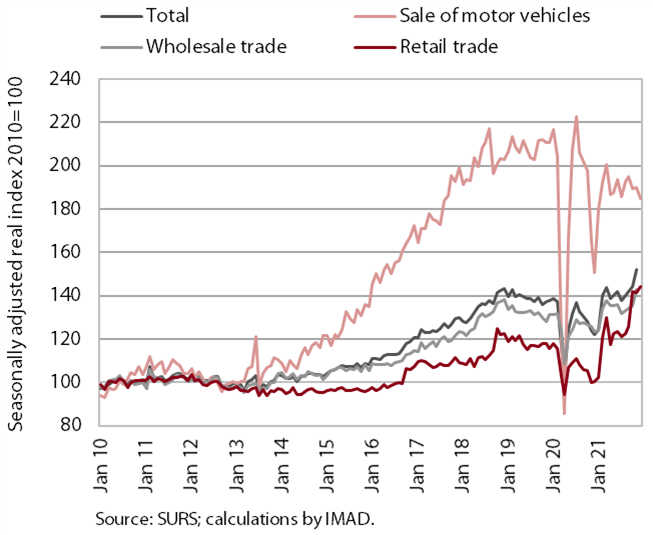
Turnover in trade increased further last November. The monthly growth was mainly due to growth in wholesale trade. Turnover in the sales of motor vehicles remained at the (low) level reached and, due to delays in the delivery of vehicles, this was the only major segment that fell short of 2019 turnover. Turnover in retail sales also remained at the level reached, with further growth in turnover in the sales of non-food products and a decline in the sales of automotive fuels following high growth in the previous month. Turnover in the sales of food, beverages and tobacco was also lower, declining further last December, according to preliminary data. After stagnating in 2020, turnover in the latter increased by 7.9% year-on-year in 2021 and by 18.8% in the retail sector as a whole, with even higher growth in the sales of automotive fuels and non-food products.
Turnover in market services
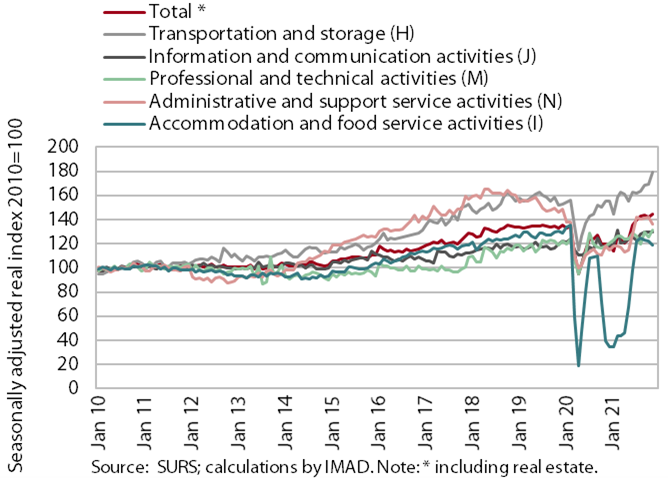
Real turnover in market services rose again last November. It was up by 2% compared to the previous month and by 18.9% year-on-year. Turnover grew strongly in transportation and storage and professional and technical activities, mainly due to renewed strong growth in land transport and architectural and engineering services. Turnover in information and communication activities remained at the previous month’s high level. After stagnating in the previous months, the sharpest decline in turnover was recorded in administrative and support service activities, mainly due to a further decline in turnover in employment agencies. With the further worsening of the epidemic situation and the restrictions on business operations, turnover further declined in accommodation and food service activities. Turnover in November 2021 was higher year-on-year in all market services, and compared to the same month in 2019, only travel and employment agencies saw significantly lower turnover (by 46% and by 22% respectively).
Selected indicators of household consumption
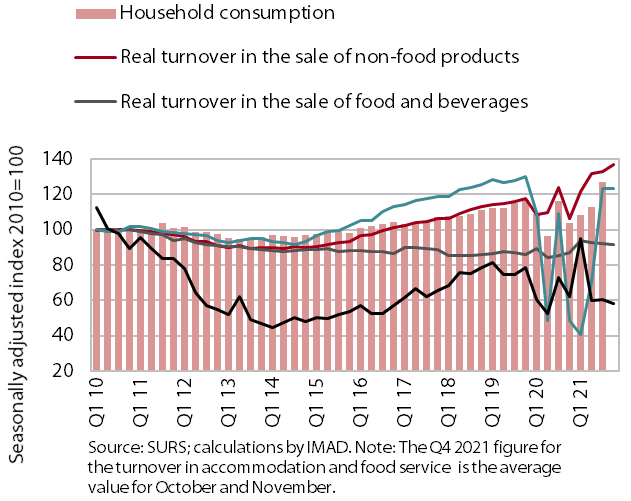
Household consumption remained high in the final quarter of 2021 and was significantly higher than a year ago, partly due to the low base. Compared to the third quarter, spending on non-food products further increased – with the deterioration of the epidemiological situation, sales of pharmaceutical and medical products and sales via mail order and the internet also rose strongly in November. Sales of automotive fuels also rose strongly, due both to higher sales to households and legal entities and to sales to transit customers. Relatively high household spending on food and beverages and on accommodation and food service activities (in the domestic market), which was also influenced by the redemption of vouchers, also continued. Sales of passenger cars to households remained at a very low level, which was also affected by the extended delivery times due to supply chain disruptions. Year-on-year consumption growth strengthened significantly in all segments compared to growth in the third quarter, mainly due to low sales caused by the restrictions on the sale of goods and services in the final quarter of 2020.
Economic sentiment

The economic sentiment indicator rose in January for the third month in a row and remains well above the long-term average. On a monthly basis, confidence rose in most activities, while in manufacturing and among consumers it remained at the same level as last December. Confidence was significantly higher in January than in the same period last year, when stringent measures to contain the spread of the epidemic were still in place (confidence was particularly low in retail trade and among consumers). Confidence in manufacturing and construction was also higher than in the same period in 2019. Confidence was also well above the long-term average in construction (up 39 p.p.) and in manufacturing (up 10 p.p.). Despite the improvement in economic sentiment, there are still some limiting factors present. The deterioration in manufacturing is the result of the current situation in the international environment (supply bottlenecks and rising non-energy commodity and energy prices), while the deterioration in retail trade and among consumers is related to uncertainty about the epidemiological situation and the measures taken.
Number of employed persons

Employment rose further in November, reaching its highest level measured to date. The highest year-on-year increases were recorded in accommodation and food service activities and construction, with employment in the latter significantly higher than in November 2019, while employment in the former remained below the level of two years ago. The containment measures also had a strong impact on the arts, entertainment and recreation, where the number of employed people also remained lower in November than in the same period of 2019. In the first 11 months of last year, the number of employed persons was 1.2% higher than in the same period of 2020 and 0.5% higher than in the same period of 2019. Amid rapid economic recovery, employment growth is still largely dependent on the hiring of foreign workers (their contribution to total employment growth was almost 50% in November), as was the case before the outbreak of the COVID-19 epidemic. This is a consequence of demographic change and the related shortage of domestic labour, which is most pronounced in accommodation and food service activities and construction (both having a high job vacancy rate). The economic sectors with the highest share of employed foreign workers in the first 11 months were construction (43%), transportation and storage (31%), and administrative and support service activities (24%).
Number of registered unemployed persons
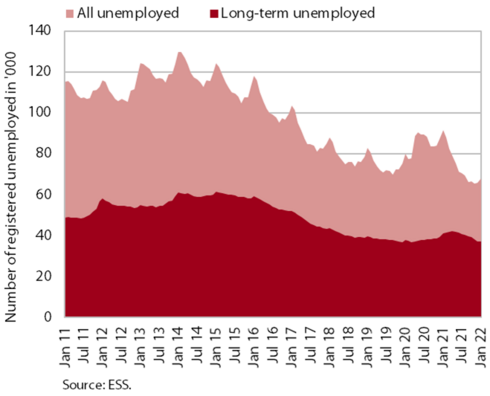
According to seasonally adjusted data, the number of registered unemployed persons fell further in January (by 2.6%). According to original data, 67,834 people were unemployed at the end of January, 2.8% more than at the end of December last year. This largely reflects seasonal trends related to a higher inflow into unemployment due to expiry of fixed-term employment contracts. The number of unemployed was 25.9% lower than last year and 15% lower than in January 2020. Among the unemployed, the number of long-term unemployed rose in the first four months of last year but then fell again by the end of the year given the high demand for labour, which is also reflected in the high rate of job vacancies. The number of long-term unemployed continued to fall in January, by 10.4% compared to January last year and by 2.2% compared to the pre-epidemic period two years ago. Of the long-term unemployed, more than half have been unemployed for more than two years.
Average gross wage per employee
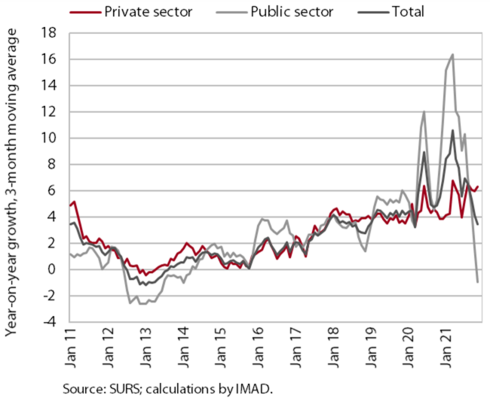
In November 2021, average wages in the public sector were 4.1% lower year-on-year, while they were 7.2% higher in the private sector. Due to the cessation of epidemic-related bonus payments, year-on-year wage growth in the public sector slowed significantly in the second half of last year and already turned negative in November. In the first 11 months of 2021, these wages were 7.8% higher than in the same period of 2020. In the private sector, average wages increased by 5.9% year-on-year in the first 11 months, mainly due to the impact of the minimum wage increase at the beginning of the year, but also to the return to employment of workers who had participated in job-retention measures. According to our estimates, wage growth in some private sector activities (manufacturing, construction, and accommodation and food service activities) could also be the result of labour shortages. The year-on-year increase in private sector wage growth last November was also influenced by extraordinary payments (13th salaries and Christmas bonuses), which were higher than in the same periods of 2020 and 2019 given the good performance of companies.
Consumer prices
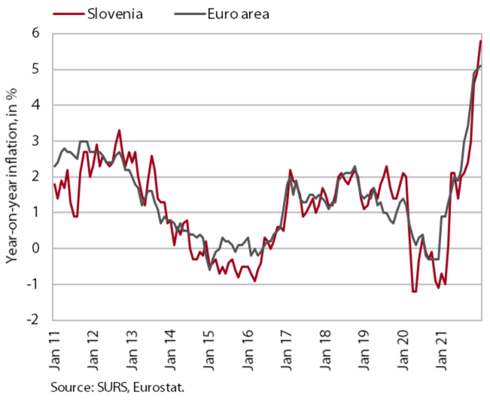
Due to higher prices of energy, food and services, consumer prices rose significantly year-on-year in January, reaching 5.8%, the highest level since August 2008. Year-on-year inflation continued to be driven mainly (2.2 p.p.) by higher energy prices. In January, gas prices rose more significantly month-on-month (by more than a quarter), and prices for petroleum products and electricity were also higher. Higher prices of energy and raw materials and persistent bottlenecks also had an impact on the rise in prices of non-energy industrial goods, especially of non-durable goods, which were already 8.2% higher year-on-year, as prices for vehicles and furniture continued to rise. Prices of semi-durable consumer goods fluctuated significantly year-on-year, reflecting slightly different seasonal developments in the prices of clothing and footwear, which were 2.7% higher in January. Prices in the food and non-alcoholic beverages group continued to rise, increasing by 4.6% year-on-year. Service price growth is also picking up and was above 3% year-on-year in January for the first time since the outbreak of the epidemic. In our view, inflation was mainly driven by services in the culture and recreation and accommodation and food services groups.
Slovenian industrial producer prices
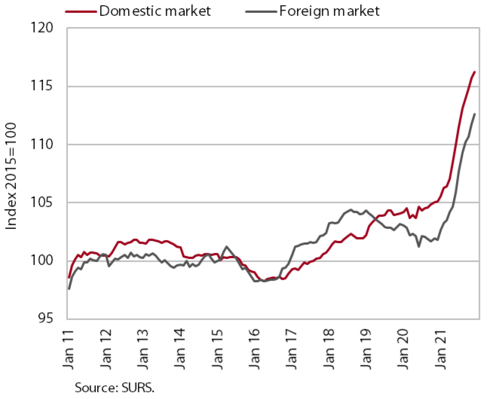
Slovenian industrial producer prices continue to rise, by 10.6% last year. Price growth was the same in domestic and foreign markets and prices increased in all industrial groups. Overall growth continued to be driven mainly by commodity prices, which rose by around 16% year-on-year. The increase in capital goods prices remained largely unchanged year-on-year (8.5%) until the end of the third quarter. The increase in energy prices was slightly higher (9.3%) than that in capital goods. Given solid consumption, production bottlenecks, and higher commodity and energy prices, consumer prices are also rising, by 3.6% year-on-year. Prices in the durable goods group rose somewhat more strongly, by 4.4%, while prices for non-durable consumer goods increased by 3.4% year-on-year.
Current account
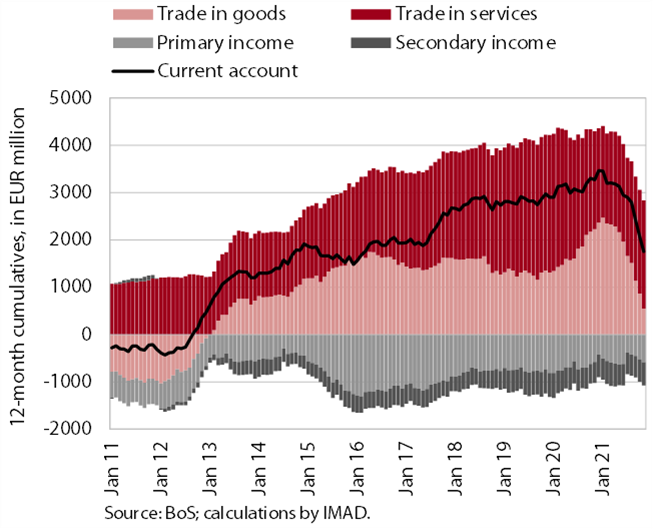
The current account surplus in the 12 months to November 2021 was down year-on-year, totalling EUR 1.8 billion (3.5% of estimated GDP). This was mainly due to a smaller trade surplus, as imports of goods grew faster than exports in the face of stronger domestic consumption and deteriorating terms of trade. Primary and secondary income deficits were also higher. Net outflows of primary income continued to rise, mainly due to higher net payments of income on equity. Net outflows of secondary income were higher, mainly due to higher VAT- and GNI-based contributions to the EU budget. The surplus in services trade was higher year-on-year, especially in trade in construction services and trade in higher value-added services (research and development services and telecommunications, computer and information services).
Year-on-year increase in domestic non-banking sector deposits
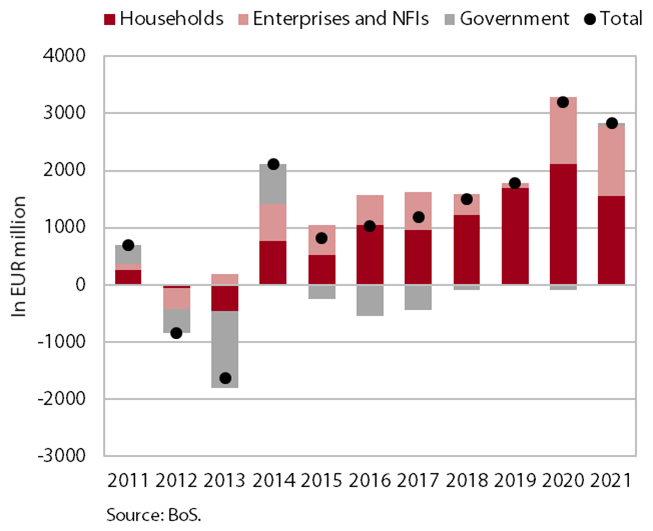
Year-on-year growth in the volume of bank loans to domestic non-banking sectors increased at the end of the year, approaching 5%, the highest level in ten years. The higher growth (2.8 p.p.) was mainly driven by a 6.2% increase in loans to enterprises and NFIs. These were seasonally lower in December compared to the previous month, but net loan repayments were at their lowest level in five years. Household borrowing growth also strengthened somewhat with a further increase in housing loans, and the year-on-year decline in consumer credit also slowed in December. Growth in domestic non-banking sector deposits is gradually declining but remains relatively high. The volume of deposits of non-financial corporations, which fluctuates slightly month-on-month depending on liquidity needs and inflows, was 12.2% higher year-on-year. Household deposit growth slowed from 10% at the end of third quarter to 6.8% in the final quarter of last year, lower than before the outbreak of the epidemic, due to higher household spending, a higher base and the search for more profitable investments. Banks’ dependency on foreign bank financing declined slightly and reached 4.1% of the banking system’s total assets.
Consolidated general government budgetary accounts
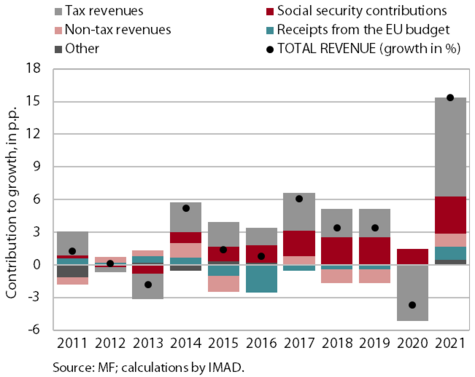

The deficit of the consolidated general government budgetary accounts amounted to EUR 2.9 billion in 2021 and was 0.6 billion lower than in 2020. This reflects the high growth in revenue (15.4%), which exceeded the 2019 level last year after a decline in 2020, and the slower growth in expenditure (10.1%). Revenue growth is the result of a recovery in economic activity, especially domestic demand and more favourable labour market conditions. Growth resulted mainly from higher revenues from value added tax, social contributions, personal income tax and corporate income tax. Among the most important tax revenues, only excise revenues remained below the 2019 level. Growth in non-tax revenues has also strengthened, due to extraordinary revenues from new borrowing and concessions granted for mobile telephony licences and from growth in revenues from the EU budget. In addition to lower expenditure growth, the structure of growth was different last year, with a higher contribution for public servants’ wages (payments for allowances for work in hazardous conditions during the epidemic, promotions and implementation of the agreement on wages), investment and payments to the EU budget, while expenditure on subsidies, which had increased in 2020, fell sharply. As in 2020, current transfers to individuals and households also increased (11.1%) due to solidarity allowances, transfers to the unemployed and the partial reimbursement of uncovered fixed costs. In 2021, total expenditure on measures to mitigate the consequences of COVID-19 amounted to EUR 2.8 billion, most of it on allowances for public sector workers and reimbursement of fixed costs to companies. The general government deficit, which arose solely from the state budget, amounted to EUR 3.1 billion, i.e. 6.1% of GDP, while the balance sheets of the Health Insurance Institute and municipalities recorded a surplus. However, as expected, it did not reach the autumn estimate from the adopted Ordinance (EUR 3.9 billion, i.e. 7.9% of GDP), due to significantly higher tax revenues and lower expenditure, especially on investment.
Receipts from the EU budget
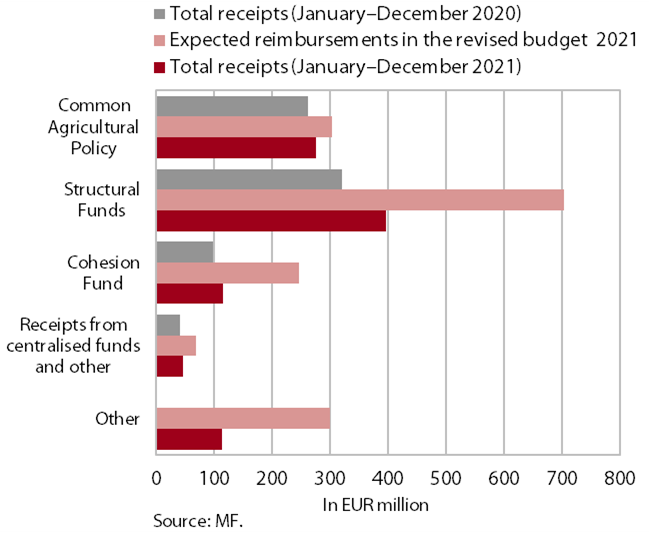
In 2021, Slovenia’s net budgetary position against the EU budget was positive (at EUR 317.6 million). During this period, Slovenia received EUR 946.4 million from the EU budget (58.4% of receipts envisaged in the state budget for 2021) and paid EUR 628.9 million into it (111.3% of planned payments). The bulk of receipts were resources from structural funds (41.8% of all reimbursements to the state budget) and resources for the implementation of the Common Agricultural and Fisheries Policy (29.1%), while the shares of resources from the EU Cohesion Fund (12.1%) and from the Recovery and Resilience Plan (12%) were significantly lower. According to SVRK data, by the end of December, operations confirmed (including REACT-EU) accounted for 98% and disbursements for 68% of the allocated funds.
